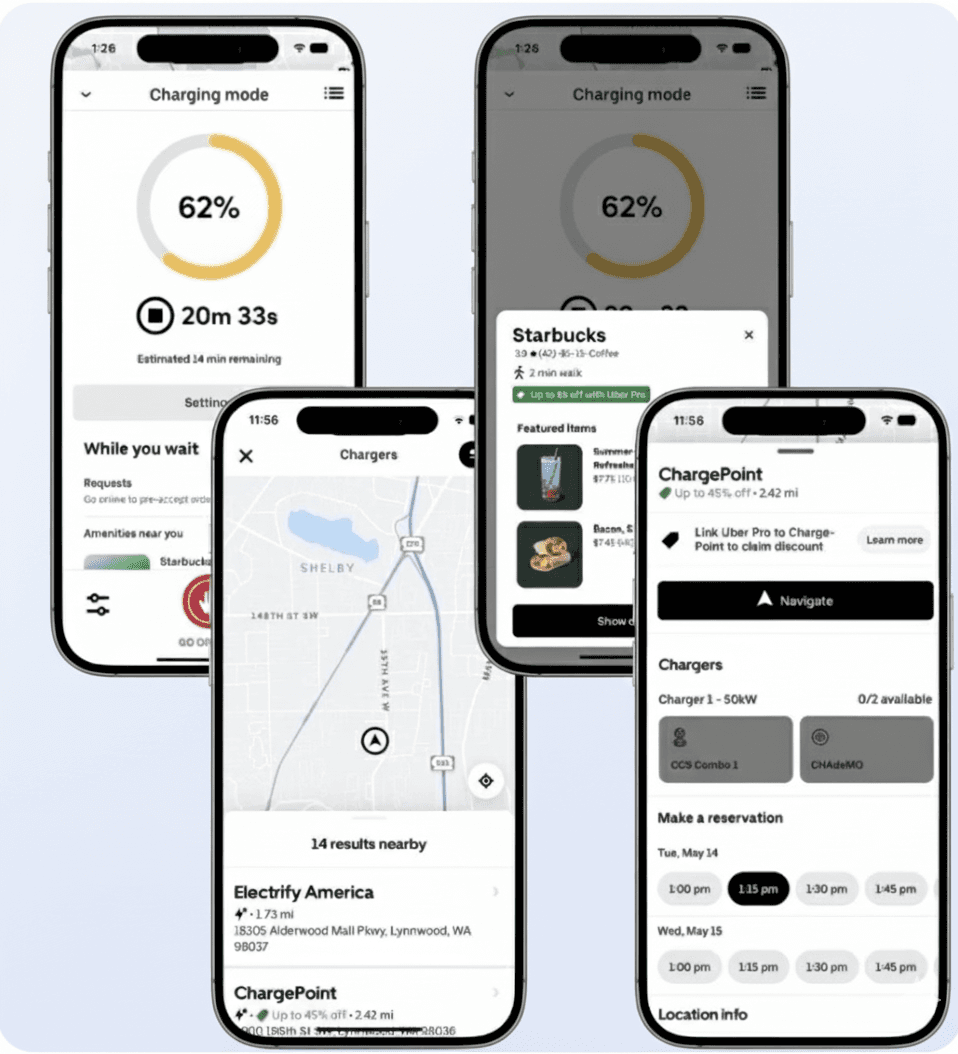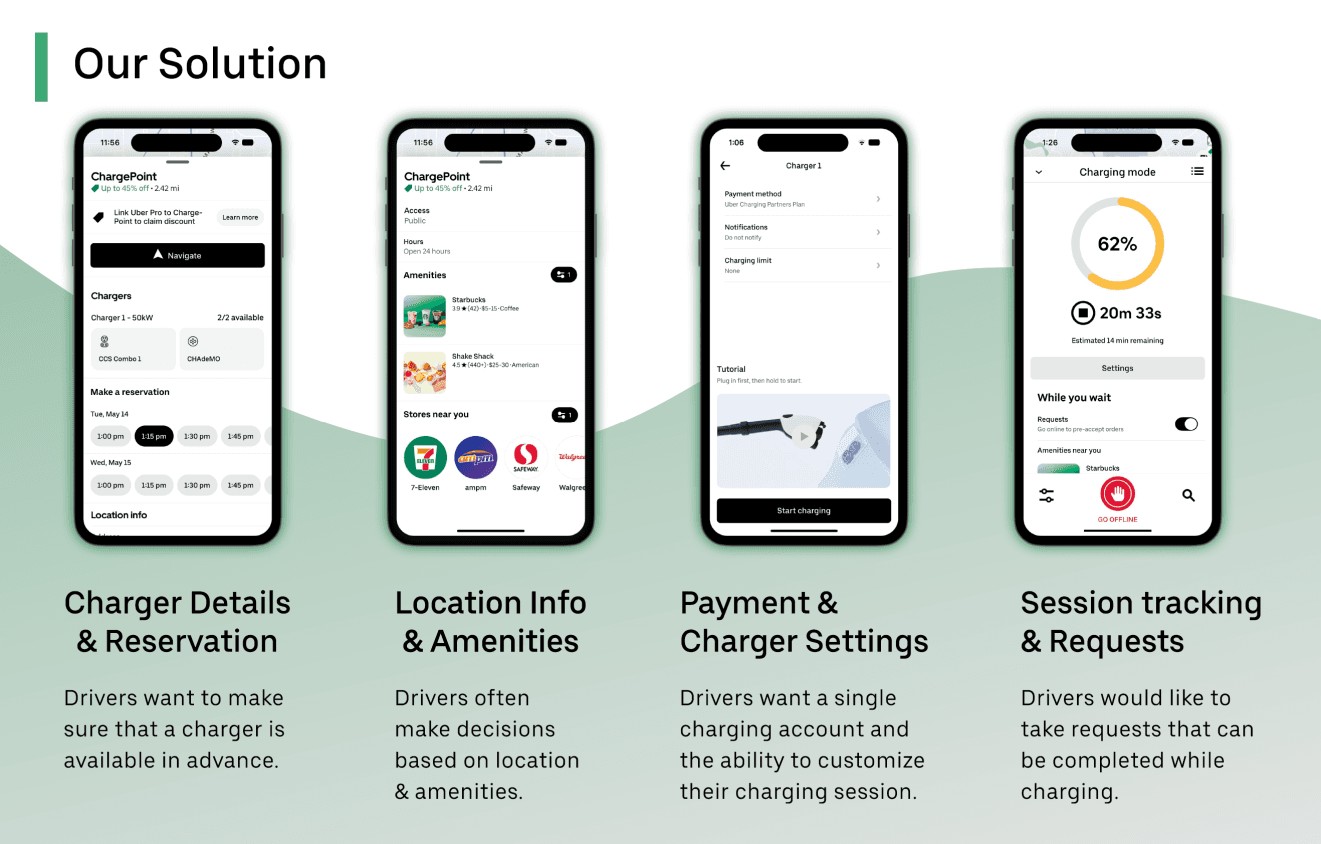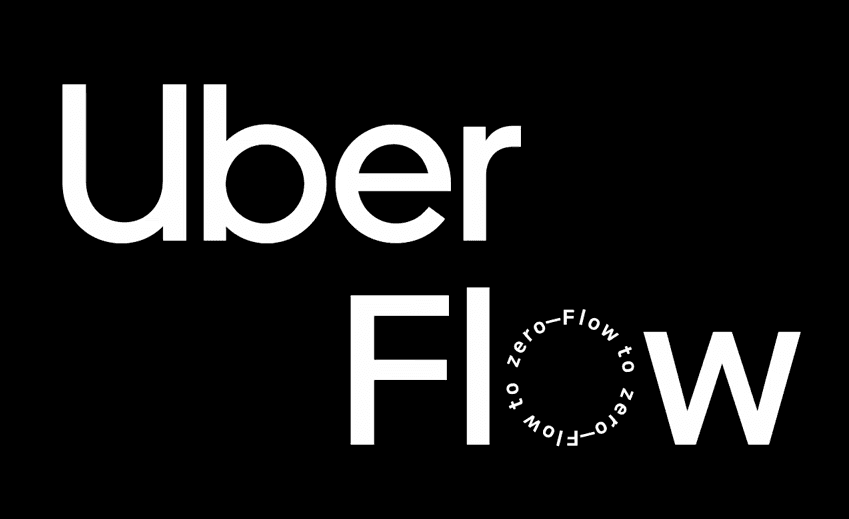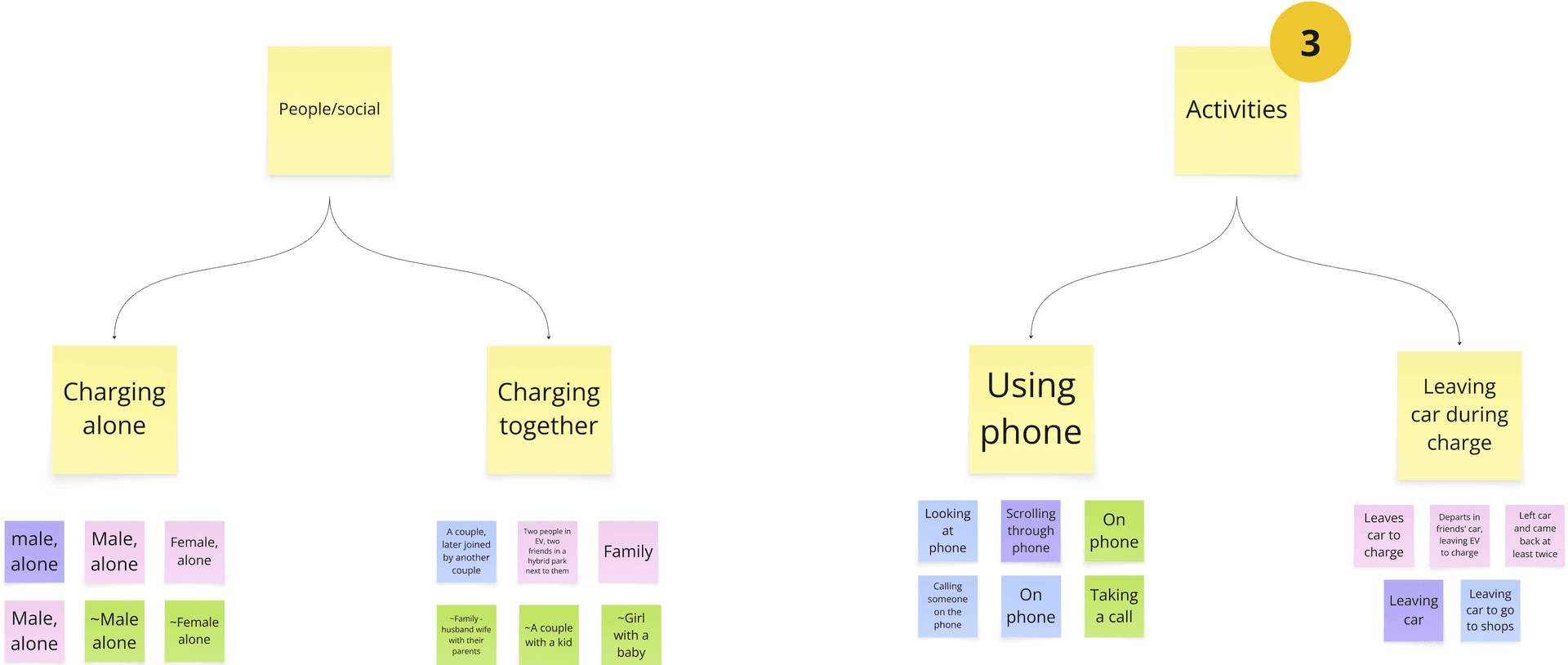UberFlow
Optimizing EV driver experience by integrating charging solutions and maximizing productivity
This project, sponsored by Uber, aims to enhance the electric vehicle (EV) charging experience for Uber drivers. The goal is to integrate the entire charging process within the Uber Driver app, streamlining the experience from locating a charging station to payment and monitoring, thereby supporting Uber's commitment to zero emissions by 2040.

Project Goals
App Integration
Seamlessly integrate EV charging features into the Uber Driver app
Streamlined Process
Simplify station discovery, payment, and monitoring
Sustainability
Support Uber's zero emissions goal by 2040
Research
Uncovered key pain points through mixed-method studies with EV drivers.
Ideation
Generated user-centered concepts to streamline the charging experience.
Design
Crafted intuitive workflows aligned with Uber's brand and driver needs.
Prototype
Built interactive prototypes to simulate real-world charging scenarios.
Evaluation
Validated designs through usability testing and iterative refinement.
My Role
Led end-to-end UX efforts—research, UX design, prototyping, and usability testing—to craft a seamless EV charging experience for rideshare drivers within the Uber Driver app.
Anushreya Karir – UX Researcher & Designer
Process overview and responsibilities
Problem Space
EV drivers currently face challenges such as range anxiety, the need to use multiple apps for charging, and inefficient use of downtime at charging stations. These issues lead to increased mental load and reduced productivity for Uber drivers, impacting their earnings and overall experience.
Design question
How might we create a seamless, end-to-end charging experience within the Uber app for EV drivers, prioritizing efficiency to minimize disruptions to scheduled trips and eliminating the need for external applications?


Research & Methodology
Research Methods
- Observational studies
- Surveys (200+ responses)
- Interviews
- Competitive analysis
- Journey mapping
- Usability testing
Observational studies
8 hrs of fieldwork | 6 sites | 50+ drivers observed | 3 major UX themes uncovered


Grouped observations highlighting how users prefer to pay, monitor charging, handle charger types, and choose fast charging options.
Survey
- Distributed to EV drivers in the US, including Uber ride and delivery drivers.
- Targeted 80+ responses to identify patterns and trends.
- Included demographic questions and specific questions for rideshare and food delivery drivers.
- Purpose: To understand user perceptions, preferences, and pain points related to EV charging.
- Amplified on social media to get responses from drivers.
Interview
- Conducted 8 interviews.
- Explored in-depth experiences and preferences regarding EV charging.
- Provided qualitative insights to supplement survey findings and inform design solutions.
Competitive Analysis
To inform our design strategy, we conducted a competitive analysis of leading EV charging apps, including PlugShare, ChargePoint, and Electrify America. This process helped us identify industry standards, strengths, and gaps, guiding our feature selection and ensuring our solution delivers a seamless, user-centered charging experience for Uber drivers.
PlugShare (iOS)
126K Ratings
#26 in Navigation
ChargePoint (iOS)
18K Ratings
#13 in Navigation
Electrify America (iOS)
27K Ratings
#23 in Navigation
Key Research Insights
Pain Points Identified
- Lack of in-app charging station integration
- Unpredictable charging times
- Limited incentives for EV drivers
- Range anxiety and inefficient routing
Driver Feedback
"I have to use three different apps just to charge my car. It's frustrating and wastes time between rides."
"I never know how much charging will cost until I'm already plugged in. Better pricing transparency would help."
"Range anxiety is real. I'd drive electric if the app could help me plan charging stops better."
Information Architecture
Information Architecture
EV Charging App User Flow
Wireframes
These wireframes illustrate the core user flows for finding, reserving, and managing EV charging stations within the app. They highlight intuitive navigation, real-time charger availability, reservation features, and integrated charging progress tracking—all designed to streamline the charging experience for Uber drivers.
Usability testing
After the initial prototype development, we conducted usability testing to gather feedback and identify areas for improvement. Conducted usability tests with eight EV drivers using Uber or similar ridesharing services.
Participants interacted with the low-fidelity prototype, completing specific tasks related to the EV charging process. Observations and feedback were collected to understand user experiences, pain points, and areas for improvement.
Incorporated feedback into the design, resulting in a high-fidelity prototype.
Final Designs
Key Features
- Integrated charging in app navigation
- Real-time availability and pricing
- One-tap payment and session management
- Push notifications for charging updates
Impact Metrics
Reduced charging session setup time
Increased driver satisfaction scores in pilot testing
Reflections & Learnings
Balancing Tech Feasibility with Driver Convenience
One of the biggest challenges was ensuring that our design solutions were technically feasible within Uber's existing infrastructure while maximizing convenience for drivers. This required close collaboration with engineering teams and multiple iterations to find the right balance.
Importance of Iterative Testing
Regular usability testing with actual Uber drivers revealed insights that wouldn't have been apparent from internal testing alone. Each iteration brought us closer to a solution that truly addressed driver pain points in real-world scenarios.
Collaboration with Uber Stakeholders
Working with product managers, engineers, and business stakeholders at Uber taught me the importance of aligning design decisions with business objectives while keeping user needs at the forefront. Regular stakeholder reviews ensured our solution would be viable for implementation.
Outcome
The UberFlow project successfully demonstrated how human-centered design can address complex challenges in mobility and sustainability. By integrating EV charging functionality directly into the Uber Driver app, we created a seamless experience that removes barriers to electric vehicle adoption. The project showcased the power of thorough user research, iterative design, and stakeholder collaboration in creating solutions that benefit both users and business objectives. This work contributes to Uber's broader mission of creating sustainable transportation solutions and highlights how thoughtful UX design can drive meaningful environmental impact.